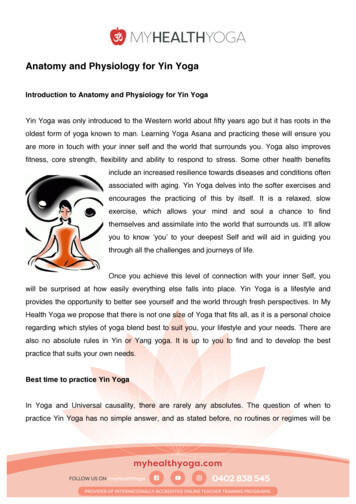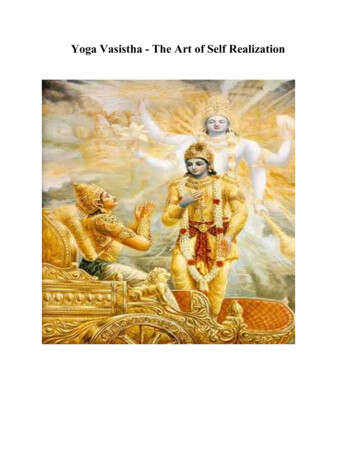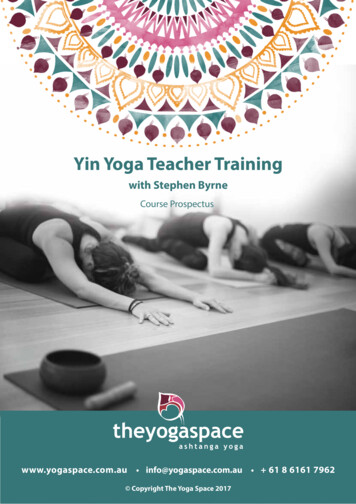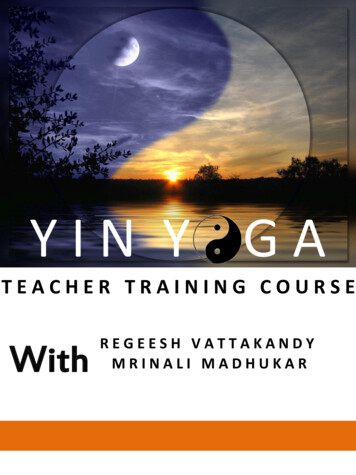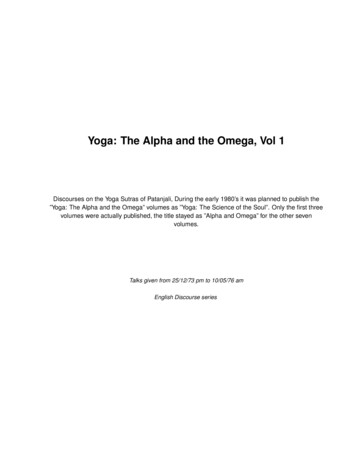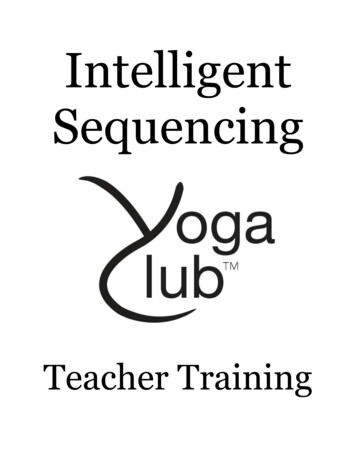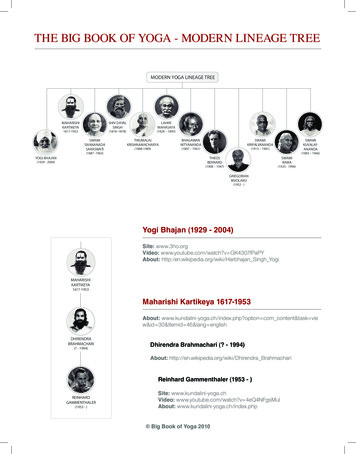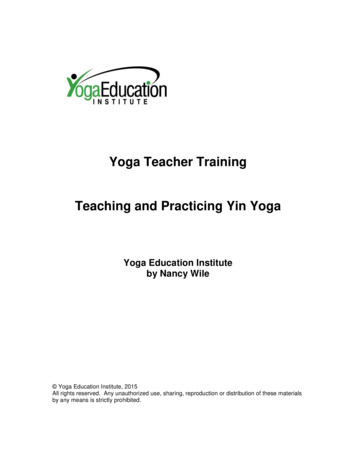
Transcription
Yoga Teacher TrainingTeaching and Practicing Yin YogaYoga Education Instituteby Nancy Wile Yoga Education Institute, 2015All rights reserved. Any unauthorized use, sharing, reproduction or distribution of these materialsby any means is strictly prohibited.
Table of ContentsIntroduction .History of Yin Yoga Benefits of Yin Yoga .Yin and Yang Compared How to Practice Yin Yoga .22456Yin Yoga Postures .Dangling (Easy forward fold) .Squat (Malasana) .Toe Squat .Camel (Uttanasana) Child’s Pose (Balasana) Ankle Stretch .Dragon (Low Lunge - Anjaneyasana) .Melting Heart (Anahatasana) Frog Seal and Sphinx .Saddle (Reclined Hero – Supta Virasana) .Thread the Needle Swan and Sleeping Swan (Pigeon and Lying Pigeon) .910121416182022252729323436Shoelace (Knee to knee) Dragonfly (Seated Straddle) Square (Double Pigeon) .Caterpillar (Seated forward fold – Paschimottanasana) Butterfly (Cobbler’s pose) Half Butterfly (One leg seated forward fold – Janusirsasana) Deer 38404244464850Cat pulling its tail .Snail (Plow – Halasana) .Happy baby Twisted Roots (Reclined Twist) Bananasana (C-Shape Stretch) .Savasana 525456586062Sequencing .Counter Poses .Finishing a Yin Practice .Sample Lesson Plans .Sample Yin Yoga Transcript .Create Your Own Yin Yoga Practice .6465666772731
IntroductionYin Yoga is a more meditative approach with a physical focus that is much deeperthan typical hatha yoga practices. Here the practitioner is trying to access thedeeper tissues such as the connective tissue and fascia and many of the posturesfocus on areas that encompass a joint (hips, sacrum, spine). As one ages, flexibility inthe joints decreases and Yin yoga is a wonderful way to maintain that flexibility.People who practice yin yoga often refer to the more active forms of hatha yoga as“yang” practices.Yin Yoga was initially called “Daoist” yoga, and was practiced to help regulate theflow of energy in the body, while targeting the deep connective tissues and the fasciathat covers the body. Yin Yoga postures are more passive postures, mainly on thefloor and fewer postures are included in a typical yin practice than in the morecommon yang like practices. Yin Yoga is unique in that you are asked to relax in theposture, soften the muscle and move closer to the bone. While yang-like yogapractices are more superficial, Yin offers a much deeper access to the body. It is notuncommon to see postures held for five minutes, even 20 minutes at a time. Thetime spent in these postures is much like time spent in meditation. Many of the Yinpostures are similar to those in a yang style class, but they are usually calledsomething else. This is done to help students realize the different intention of thepostures in yin yoga, and to shift from active to passive.This intimate practice of yoga requires students to be ready to get intimate with theself, with feelings, sensations, and emotions, something of which can be easy toavoid in a fast paced yoga practice. Yin yoga is often used in programs that dealwith addictions, eating disorders, anxiety and deep pain or trauma. It can be helpfulfor people who struggle with being alone, sitting with feelings and sensations. Thispractice can help people develop greater mental, basically “learning to sit still.”History of Yin YogaWe know that the use of yin postures in yoga is not new. It has been around sincethe beginning of the physical practice of yoga. Thus no one person can be givencredit for inventing yin postures. There was a time when all yoga was yin-like, andperhaps the balance was too far in that direction. A rebalancing occurred when yangpostures grew in prominence. However, as time went on, yoga practice becamemore and more yang-like. Nature desires balance - we could say she demandsbalance. Yoga could not continue to be more and more yang without someonefinding a way to bring it back into balance.In the last decade of the 20th century, two teachers did start to bring yin posturesback into the prominence they once had in the yoga world: Paul Grilley and SarahPowers. Paul was first exposed to instances of long held postures in 1989, whileattending Paulie Zink's Taoist Yoga classes, which he began in the 1970s. Thehistory of the term, Taoist Yoga is also interesting. It is not a term that has been inuse for very long. Its first occurrence was probably in a book called “Taoist Yoga:2
Alchemy and Immortality,” written by Lu K'uan Yu's (Charles Luk; 1898-1978) ,which he published in 1973. The practice of Taoist Yoga equates simply to Chi Kung,but by using the word "yoga" in the name, Lu K'uan Yu was able to leverage thegrowing popularity of yoga to help students become interested in Chi Kung. After LuK'uan Yu, a few other teachers, like Mantak Chia in the 1980's, also began to refer totheir Chi Kung as Taoist Yoga as well. "Taoist Yoga" is part of what may be referredto as Popular Western Taoism, a form of New Age hybrid spirituality thatappropriates some aspects of the religious tradition which is Daoism in order toincrease cultural capital and marketability.It was in the Taoist Yoga classes that Paul Grilley attended where Paulie Zink offeredasana practice that included both yin postures and yang movements. While Paulie'sTaoist Yoga was interesting, Paul resonated with was the long held postures. He gotthe idea that an entire yoga class could be yin in nature without any yang posturesat all: an entire Yin Yoga practice was possible. He started offering this "all-yin"practice to his own Hatha Yoga students, and they too started to resonate with thepractice. This was a new way to look at a very old paradigm. Unlike RestorativeYoga, which can also be viewed as yin-like, Paul's Yin Yoga was designed for healthystudents, who could be pushed further physically. Paul Grilley's modern Yin Yogawas not easy: it was challenging. It took people outside their normal comfort zone,just as yoga had always done.Sarah Powers became a student of yin yoga that she learned from Paul Grilley, andonce Paul had worked out the physiological and energetic pathways to health andwholeness that Yin Yoga was utilizing, Sarah began to share her understanding withher own students. They in turn wanted to learn more. Sarah was the one whocoined the term "Yin Yoga." Until then, Paul had been referring to his practice asTaoist Yoga, because that is what Paulie Zink had called his practice. But Sarahpointed out that what she and Paul were offering was not the Taoist practice taughtby Paulie, but a revamped subset of his teaching. They were offering only the yinpostures, so the practice should be called Yin Yoga.Sarah's and Paul's students eventually became teaches in their own right. Yin Yogabegan to establish an open source lineage through these teachers, and the practicecontinued to spread: a critical mass was building - one that would soon bring theyin-side of yoga into thousands of yoga studios throughout the world.3
Benefits of Yin YogaSome of the benefits of Yin yoga are: Calming and balancing to the mind and body Regulates energy in the body Increases mobility in the body, especially the joints and hips Lowering of stress levels (no one needs that) Greater stamina Better lubrication and protection of joints More flexibility in joints & connective tissue Release of fascia throughout the body Help with TMJ and migraines Deeper Relaxation A great coping for anxiety and stress Better ability to sit for meditation Ultimately you will have a better Yang practiceIf you incorporate a little of both yin and yang style yoga, you can create a morewell-rounded practice. If you take a peek at a Yin-Yang symbol, it is suggesting thatno matter what, we should take a “tiny bit” and put it in the heart of its opposite.Knowing both practices. Yin yoga can teach you to truly be still, to really come faceto face with yourself, and to bring what yin teaches you into your more yang likepractices and ultimately your life as a whole.On a physical level, Yin enhances the natural range of motion in the joints. Bykeeping your muscles soft, you release deep layers of connective tissue, creatingmore ease in any style of yoga and in seated meditation. On an energetic level, Yinenhances the flow of prana (life force) in the tissues around the joints, where energyoften stagnates. The practice is often likened to doing an acupuncture session onyourself: Sequences are often geared toward strengthening certain energy channels(called nadis in yoga or meridians in Chinese medicine), which ultimately supportthe organs, immune system, and emotional well-being.And then there are the mental benefits: Holding poses for three to five minutes oftenbrings up discomfort. Yin conditions you to stay with the intense sensations thatarise, rather than quickly moving into the next pose. It trains you to become morecomfortable with discomfort instead of becoming alarmed. It marries meditationand asana into a very deep practice.Yin yoga teaches you how to really listen, you don’t get the opportunity to go in andout, jump around and find a distracted version of stillness within your practice. Yinis such a great compliment to other styles and your own personal life, because itbrings long periods of time in an uncomfortable position, which then asks you tolearn to “be” to “accept what is” in that given moment. Something we can all benefitfrom.4
Yin and Yang ComparedMany forms of hatha yoga today are dynamic and active practices designed to workthe muscular tissues, or as yin yoga would say, the “yang” tissues of our bodies. Yinyoga allows students to work with the other “yin” parts or deeper parts of theirbodies, including ligaments, joints, fascia, and bones. Because of the more fragilenature of these parts of the body, Yin yoga allows for a much slower practice, whichis focused on yielding, allowing, and nourishing. The very slow pace can initiallyseem boring to students who are used to a more active form of hatha yoga, but thestillness allows for a deeper experience which can be challenging and, ultimately,very fulfilling. Most Yin yoga teachers encourage students to continue practicingyang forms of hatha yoga in addition to Yin yoga. This reflects the belief in the needto have a balance of yin and yang and an understanding that the two thingscomplement each other, and provide specific benefits.Yin yoga is based on the Taoist concepts of yin and yang, opposite andcomplementary principles in nature. Yin could be described as stable, immobile,feminine, passive, cold, and downward moving. Yang is understood to be changing,mobile, masculine, active, hot, and upward moving. The sun is considered yang, themoon yin. In the body, the relatively stiff connective tissues (tendons, ligaments,fascia) are yin, while the more mobile and pliable muscles and blood are yang. Morepassive asanas in yoga are considered yin, whereas the more active, dynamic asanasare yang, because they stimulate the muscles and generate heat. Sarah Powers andher colleagues say that yin yoga is most effective when more active, or yang forms ofyoga or exercise are also practiced, either immediately before or after a yin session,or separately.In Yin yoga, rather than using your body to get into the posture, you use the postureto get into your body.Yin tissues include: ligament, bones, and jointsYang tissues include: muscles, blood, skinYang styles of yoga typically target the muscles and use rhythmic repetitivemovements to stress the fibers and cells of the muscles. Since the yang tissues areelastic and moist, they respond well to this type of stress. However, since Yintissues can be thought of as dryer and less elastic, they are more prone to damagewhen stressed too much. They require gentler pressures that are applied for longerperiods of time, in order to be stimulated and to grow stronger.Generally, one of the jobs of muscles is to protect the joint from too much stress. So,in yang forms of yoga, the body is placed in careful alignment and certain musclesare contracted to protect the joints. However, Yin yoga is specifically designed toexercise the ligaments and to regain space and strength in the joints.5
Physically, hatha yoga can be thought to help both stability and mobility. The yangpart of a practice helps with stability, while the yin part of a practice helps withmobility. According to Yin yoga, it is important not to apply yang practices to yintissues. In yin yoga, we are not trying to stretch the ligament or joint, but are tryingto offer a small stress to that ligament or joint to help it become stronger and moremobile.Yin yoga poses apply moderate stress to the connective tissues—the tendons, fascia,and ligaments—with the aim of increasing circulation in the joints and improvingflexibility. They are also designed to improve the flow of qi, the subtle energy said inChinese medicine to run through the meridian pathways of the body.Improved qi flow is hypothesized to improve organ health, immunity, and emotionalwell-being. A more meditative approach to yoga, yin aims at cultivating awarenessof one's inner silence, and bringing to light a universal, interconnecting quality.Yin yoga employs specific sequences of poses aimed at stimulating particularmeridians, or subtle channels, as understood in Traditional Chinese Medicine (TCM.During the long hold times of the yin asanas, teachers usually give "dharma talks,"informal monologues drawing from a variety of sources, according to teachers'choice. They will often explain the physiology and anatomy of poses, including thelocation of the meridian lines being affected. They may tell traditional yoga stories,recite yoga sutras, or reflect on their own experience.PhysiologyMuscles account for about forty percent of the resistance against the body'sflexibility, while connective tissue accounts for about fifty percent. The intensityand physical benefits of yin yoga practice depend on two variables: duration of theasana, and the temperature of the muscle. Asanas are usually held for three to fiveminutes, but can be held for as long as twenty minutes. Because of the long durationof asanas, it is said that patience is another of the key values cultivated by yin yoga.How to Practice Yin YogaIt is usually recommended that yin yoga be practiced when the muscles are not yetwarmed up. When the muscles are cold, they are less elastic, and more stress will betransferred to the connective tissue. However, this is a general rule and for somepeople, it is better to stay a bit warm while practicing. Because this style of yogadoes not generate bodily heat, yin teachers recommend keeping the temperature ofthe room a little higher than usual. During yin asanas, muscles are relaxed to avoidmuscle spasm, which could result from engaging muscles for long periods.Distinction from hatha yogaAlthough many yin yoga poses or asanas closely resemble the asanas in regularhatha yoga, they have different names, in part to alert those who are familiar withsimilar poses in hatha yoga not to perform them in the same way. In general, theposes of yin yoga are performed with very little muscular exertion. For example, in6
the Cobra or Bhujangasana of hatha yoga, the practitioner lies prone and lifts thechest, curving the spine in an arc, reaching the legs back strongly. However in yinyoga, in the similar Seal pose, the upward movement of the trunk is entirelysupported by the arms, and the legs are relaxed.The three principles to a yin yoga practice:1) Come into the pose to an appropriate depth2) Resolve to remain still3) Hold the pose for enough timeThe first principle of Yin yoga is to go only to the point where you feel someresistance when coming into a posture. Don’t try to go as deeply as possible rightaway. Give your body a chance to open up and invite you to go deeper. After 30seconds or a minute, the body releases and greater depth may be possible. Listen tothe body and respect its requests. Once you find the position that is best for yourselfthat day, you should resolve to remain still. This means that if you start to feel likeyou want to squirm, then simply notice that impulse and allow sensations or slightdiscomforts to be there, simply observing and remaining still. Finally, it is importantto hold the pose for long enough time, so that you have the opportunity to fully comeinto stillness and fully experience the energy of the posture.In Yin yoga, there is not a great need for a lot of postures, as compared with otherforms of hatha yoga. If you are planning to hold each posture for five minutes andallow for 1 minute rest in betweeen, along with five minutes of breathing and warmup activity at the beginning and a 5-10 minute savasana and meditation at the end,you will only have time for about 12 postures in a ninety minute class. And forpostures that are done on two sides, they will count as two postures.The benefits listed in the following asana descriptions are not exhaustive, but theywill provide a guideline to help you to choose when to add a particular asana to yourpractice. If you wish to arrange your practice time around a particular area of thebody or a particular organ that needs stimulation, the advice here may be useful.Combine this knowledge with the information provided on the affected joints,meridians and organs to structure your flow.Contraindications should always be checked out before trying a posture for the firsttime. Remember, not all poses are for every body; know and respect your limits andthose of your students. If a certain pose is not right for you, don't worry about it;there are lots of other ways to work the same tissues. Choose another posture that ismore appropriate for you or your students. You will find some suggestions offeredin the alternatives and options.The recommended time to hold a pose is very subjective. The times listed representthe typical length of time in most yin yoga classes. However, some students can7
remain in the asanas much longer than indicated; others must come out muchearlier. Encourage your students to respect their body's unique needs.When coming out of a pose there will be a natural sense of fragility - we have beendeliberately pulling the body apart and holding it apart. The sense of relief is to beexpected, and even enjoyed. One of the benefits of Yin Yoga is this experience ofcoming out of the asana. After a deep, long-held hip opener, it may feel like we willnever be able to walk again - but be assured the fragility will pass. Sometimes,however, a movement in the opposite direction will help. It is helpful to usecounterposes as balancing postures that bring us back to neutral.8
Yin Yoga PosturesMany of these asanas will be familiar to experienced yoga students. However, thesestudents will notice that the name is different in the yin tradition - this is deliberate.The pose may look the same, but the intention is different. The yin pose of Swanlooks identical to the yang pose of Pigeon, but in Pigeon, as in most yang poses, themuscles are the targets. In a yang pose, we engage the muscles and stretch them. Inthe yin practice, we relax the muscles; we aim our intention into the joints and thedeep tissues wrapping them, not the more superficial tissues of the muscles or skin.There is no consensus in the world of yoga on naming asanas. Even in the yangtradition you will come across different names for the same postures and differentpostures sharing the same names. This is also true in the yin tradition; differentnames abound. The ones shown here are the names more commonly used but theyare not universal. Where two names are common, both names are given, but wehave not attempted to be exhaustive.In Yin yoga, contraindication and counter postures become even more importantdue to the length of time in each posture and the focus on affecting the deepertissues through relaxed static positioning.In each of the following postures, the Yin name for the posture is given, followed bythe yang or Sanskrit name, if applicable.9
Dangling (Easy forward fold)Benefits: Gentle stretch for the lower spine Loosens the hamstrings and warms up the quadriceps Compresses the stomach and internal organs Builds strength in the diaphragm while providing a massage for theabdominal organs Cures menstrual crampsContra-indications: Avoid if you have high blood pressure. Related conditions that are a problemwhen blood pressure is increased include diabetes and glaucoma. If you havethese conditions you may wish to avoid this pose. If you have low blood pressure, to come out of the pose, roll up to standingslowly or go into squat to avoid dizziness. If you have a bad back, bend your knees a lot! You can also rest your elbowson the thighs. If you have any lower back disorders which do not allow flexion of the spine,then do not allow the spine to round: keep the back as straight as you canand bend the knees a lot.Getting Into the Pose: Stand up, with the feet hip-width apart. Bend your knees and fold forward.Clasp the elbows with the opposite hands.Alternatives & Options: Bend knees more, which will strengthen the quadriceps and release the back. Rest elbows against a table, chair, or on the thighs if the back feels strained. Caterpillar is an easy alternative; sit down with legs straight. If you do this pose more than once, try it with legs bent the first time andstraight the second time.10
If you're really flexible, try holding the wrists behind the legs but still withsome rounding to the back.Coming Out of the Pose: Bend your knees a bit more and release your hands to the floor. Slowly rollup. This is often called Rag Doll. You can place your hands onto your shins and come up halfway, then foldback down. Do this a couple of times, and when you feel ready, come all theway up with a straight back.Counter poses: Squat or any gentle backbendMeridians & Organs Affected: Due to the intense stretch along the back of the legs and spine, the UrinaryBladder meridian is highly stimulated Great for the liver, spleen, and kidneys.Joints Affected: The Spine.Recommended Hold Times: Three minutes can be intense. Sometimes this pose is done in two or moresessions of two minutes each, separated by two minutes of Squat.Similar Yang Asanas: The yang version is known as Uttanasana, but in the Yin Yoga version theemphasis is not to stretch the hamstrings a lot, but rather to release thelower back. If the legs are straight, it is a nice stretch for the hamstrings, butthere is some muscular effort needed. If the knees are bent, it is a greatstrengthener for the thigh muscles and allows the back to release more fully.Other Notes: Ensure the arches of the feet are lifting Balance the weight between toes and heels. You can gently sway or wobble,but no bouncing. Straight legs will stretch the hamstrings; bent knees will strengthen the thighmuscles. It is more yin-like to bend the knees, bringing the chest to the thighs (you'llreceive a stomach massage, too). Can intermix this and Squat. Eventually, hold both for four minutes or morein total11
Squat (Malasana)Benefits: Opens the hips and strengthens the ankles Releases the lower back Can be a great pose to prepare the body for childbirth Offers relief to women suffering severe lower back pain due to theirmenstrual cycleContra-indications: If hips are too tight, this can torque the knees. If you have knee trauma, avoid this pose.Getting Into the Pose: Start by standing with the feet hip-width apart. Squat down and bring yourarms in front of you, hands in prayer and elbows pulling lightly against theknees or shins.Alternatives & Options: If your heels are off the floor, use a folded blanket or bolster under them. Wewant the body to relax. Another option if the heels are off the floor is towiden the distance between the feet. Watch where the knees are pointing compared to where the feet arepointing. They should point in the same direction. If they are not, spread thefeet wider or rest the heels on a folded blanket or on a bolster. When the feet are wide apart (hip width or more), this pose works into thehips more deeply. When the feet are close together (perhaps even touching), this pose worksthe ankles more deeply.12
A deep variation is to keep the feet together but with the knees wide apart.Lean forward, wrapping your arms around the shins and then behind theback, clasping the hands together.Another option is to place your hands behind your head and gently draw thechin to the chest: this adds a stretch to the back of the neck.Coming Out of the Pose: An easy exit is to just sit down and then slowly straighten the legs out in frontof you. A more challenging exit is to come to Dangling by straightening the legs andfolding forward. As you straighten the legs, align the feet so that they arepointing in the same direction as your knees.Counter poses: Dangling, as just described, helps to release the knees and back Ankle stretch or VajrasanaMeridians & Organs Affected: The Liver and Kidney lines as they run through the groin and the UrinaryBladder lines on the back. If you feel this through your ankles you may also be stimulating the Stomach,Spleen, Gall Bladder, and Urinary Bladder meridians.Joints Affected: Hips, knees and ankles.Recommended Hold Times Two to three minutes at one time; however, you can revisit this pose a coupleof times during the practiceOther Notes: Approximately two-thirds of the world's population goes to the bathroomevery day this way! If uncomfortable, it may be a sign that you need to do thismore. A nice sequence is to go from Dangling to Squat, back to Dangling, back toSquat, over and over again, holding each position for one to two minutes. Elbows in front of knees can be used as levers to pull the chest forward,allowing the tailbone to drop lower13
Toe SquatBenefits: Open toes and feet and strengthens ankles Stimulates all six lines of the lower body meridians (which begin or end inthe toes)Contra-indications: Sitting on the heels may strain the knees. If ankles or toe joints are very tight, don't stay here long.Getting Into the Pose: Begin by sitting on your heels with the feet together. Tuck the toes under andtry to be on the balls of the feet, not the tippy-toes. Reach down and tuck thelittle toes under.Alternatives & Options: If the pose becomes too challenging, stand up on the knees, relieving most ofthe pressure on the toe joints. When you feel you can handle it again, sit backdown on the heels. Don't stay if in pain! You can combine this posture with shoulder exercises like Eagle arms or CowFace arms. If the knees are uncomfortable, place a blanket under them or a cushionbetween the hips and heels. You may enjoy a rolled-up towel behind theknees, which helps to release the knee joint.14
Coming Out of the Pose: This one can be quite juicy, so come out slowly, enjoying every single minute!Lean forward onto your hands, lift your hips forward, and release your feet.Point the feet backwards and sit on your heels again. Sigh!Counter poses: Ankle Stretch or Child's Pose, or any pose that opens the ankles, such asSaddle.Meridians & Organs Affected: All the meridians of the lower body get stimulated through the compressionin the toes. The front of the ankle also becomes compressed helping to open the Spleen,Liver, Stomach, and Gall Bladder lines.Joints Affected: Toes and ankles.Recommended Hold Times: Two to three minutes.Other Notes: This pose can become quite intense for most people fairly quickly. Monitorthe level of intensity. It is better not to stay in the pose if you are in pain. If doing shoulder work while holding the pose, take a break between sides.Do an Ankle Stretch, and then come back into Toe Stretch and resume theshoulder work on the other side15
Camel (Ustrasana)Benefits: Deeply arches the sacral/lumbar spine and opens the top of the thighs;provides some opening in the ankles Stretches the hip flexors and opens the shoulders; excellent for droopingshoulders or hunched backs [1]Contra-indications: Elderly and those with spinal injuries can do this pose. [2] However, seekmedical advice if you fit either category. Without support, the back can spasm, so those with weak backs may want todo only the gentle versions (see below); If you have any neck issues, do not drop head back; keep the chin to thechest.Getting Into the Pose: The easiest way to come into Camel is to sit on your heels, place your handsbehind you on the floor, and lift your hips forward. As the hips move forward,your back will arch.Alternatives & Options: You may also come into this pose by standing on your knees and holdingyour hands on your hips. Keeping the hips forward, arch your back. (Thismay be unsuitable for people with back problems, because there is littlesupport from the hands in this version. Instead, do the hands-on-the-floorversion.) Walking the hands on the floor toward the feet may be unsuitable for peoplewith knee problems because there is more pressure in the knees in the earlystages of this variation If you're very flexible you may wish to bring your hands to the
Yoga, which can also be viewed as yin-like, Paul's Yin Yoga was designed for healthy students, who could be pushed further physically. Paul Grilley's modern Yin Yoga was not easy: it was challenging. It took people outside their normal com


